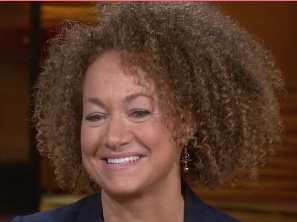
As of last Friday, Rachel A. Dolezal was no longer an employee of Eastern Washington University. But the former adjunct instructor of Africana education, who has become the focus of a fierce debate about race and identity, may have a higher profile on campus than ever before.
Ms. Dolezal, a 37-year-old civil-rights advocate, stepped down on Monday as president of the Spokane, Wash., chapter of the NAACP, less than a week after her parents asserted that she was white. For years, she has identified as black. Despite the disclosure from her parents — and the release of childhood photographs and a reverse-discrimination lawsuit she had filed against Howard University, her alma mater — Ms. Dolezal said on Monday that she continues to do so.
Her case has captivated a national audience and stoked conversations among professors in her field, especially at Eastern Washington. Faculty members there who know her are shocked and bewildered, said Scott Finnie, director of the university’s Africana-education program.
Mr. Finnie, who is African-American, said that news of Ms. Dolezal’s deception had come as such a surprise because of how she presented her personal story. Ms. Dolezal has said she was born in a teepee, encountered physical abuse from her parents, and set up a hair-braiding service to raise the self-esteem of black girls.
“It did create an abnormal shock, not only because of her appearance but because she presented herself as someone who had a strong intensity about blackness,” Mr. Finnie said. “There was this apparent connection in life experiences, not just ideology.”
In fact, Mr. Finnie said, “there was an unspoken assumption that she was biracial.” He said Ms. Dolezal had told him that her mother was white, but she introduced him and other faculty members to an African-American man whom she identified as her father.
Ms. Dolezal started teaching at Eastern Washington in 2010; her courses touched on topics including African and African-American art history and “the black woman’s struggle.” She had only intermittent interactions with the rest of the department’s faculty, Mr. Finnie said: “As a part-timer, we didn’t see her every day, all the time.”
But her civic role was prominent enough to make her the scheduled keynote speaker at the Africana-education program’s graduation ceremony. Questions about Ms. Dolezal’s race hit the news on the day of the ceremony. “She called me that morning and said, ‘Maybe I shouldn’t go, because it’ll be a distraction,’” Mr. Finnie said. “I said, ‘I think you’re right.’”
The ceremony was deluged by television reporters. Before the event, Mr. Finnie was grilled for 15 minutes. Once the program ended, reporters swarmed students and asked questions. “It took away from them celebrating their accomplishments,” Mr. Finnie said. “It was a distraction.”
On Monday her name and bio were removed from the Africana-education department’s website. David Meany, a university spokesman, confirmed that her quarterly contract expired, as scheduled, last Friday. He would not say whether she would be asked to return, though the Associated Press reported that her contract had not been renewed.
When asked if he’d invite Ms. Dolezal back to campus, Mr. Finnie said assignments for the fall quarter were still under deliberation. But he said the affair had left him with many unanswered questions about his colleague.
“Why did she do this? Why did she not disclose the truth about her apparent father? Why did she feel it was necessary?” he asked. “The struggle for social justice did not make this a prerequisite, nor does the academic work at a campus.”
Performance and Contradiction
Other scholars of race across the country were more pointed. “I have three words for Rachel Dolezal,” said Kinitra D. Brooks, an assistant professor of English at the University of Texas at San Antonio who specializes in black feminist theory: “How dare you?”
Ms. Brooks is one of a number of professors concerned that the controversy might strike a blow at the credibility of black and Africana studies, or at that of the scholars — both white professors and professors of color — who work in those fields.
“As black feminists, we have to work so hard just to be accepted and to have our critical theories considered valid,” Ms. Brooks said. “Her falsity can color what so many have previously argued as the supposed illegitimacy of black feminist scholarship.”
Not every professor shares that fear. “I don’t think there will be any real repercussions for those who do serious, strong work,” said Farah Jasmine Griffin, a professor of English and comparative literature and African-American studies at Columbia University. “I think she’s done more harm to herself than to serious black women intellectuals.”
Ms. Griffin, who is African-American, considers the fascination with Ms. Dolezal “a distraction” from more-pressing matters, like police treatment of black Americans. “The people who don’t take us seriously didn’t need her example to keep doing so,” she said.
Martha S. Jones, chair of African-American studies at the University of Michigan at Ann Arbor, said there’s no shortage of faculty members from diverse racial backgrounds who are doing valuable work in the field of black studies. “What is the value added for a woman who is seemingly white to take on the persona of a black woman?” she asked. “She can do the work without this performance.”
What some professors find both insulting and fascinating about that performance is that it has clearly drawn from black-studies scholarship, including Ms. Dolezal’s own.
“She’s been reading our scholarship and our commentary,” Ms. Jones said. “She knows if there’s an intervention to be made in terms of her presentation of self, it’s the hair. We all read each other, write about hair, and there’s a whole lit about the significance, power, and symbolism of hair for black women. She knows that hair transforms the way we are read. Rachel is a really astute student of race in a curious way.”
Tanya Golash-Boza, an associate professor of sociology at the University of California at Merced, who is white, also finds an interesting contradiction in Ms. Dolezal’s efforts to pass as black.
“On the one hand, she appears to have a deep understanding of blackness due to her professional, community, and artistic work,” Ms. Golash-Boza said. “On the other hand, her understanding of race — and of blackness, in particular — seems quite thin insofar as she seems to believe that a white woman’s performance of and appropriation of blackness is unproblematic.”
“It is hard to understand how these contradictory understandings of blackness can coexist,” she said.
‘A Kind of Violation’
For white professors who study race, Ms. Dolezal’s case is especially resonant.
“Her embarrassment becomes my embarrassment,” said Mary C. Clifford, chair of the criminal-justice department at St. Cloud State University, in Minnesota, who has been doing antiracism work for 20 years. “There are many frustrations I’ve faced as a white woman doing work on race. People ask: Are you attracted to black men? What’s wrong with you? They are constantly dehumanizing my intellect.”
Jennifer Griffiths, an associate professor of English at the New York Institute of Technology and author of Traumatic Possessions: The Body and Memory in African-American Women’s Writing and Performance, said her feelings toward Ms. Dolezal had veered from pity to outrage, confusion, and even amusement.
“As a white woman professor who has focused on race issues in my scholarship and teaching, I feel like she avoided the hard, ongoing process of addressing her white privilege as part of work toward racial equality,” Ms. Griffiths said. “Dolezal took it to a whole new level of arrogance about the ability to know someone else’s experience, and to me, that’s a kind of violation and betrayal that undermines any good intention.”
Angela D. Jackson-Brown, an assistant professor of English at Ball State University who is African-American, shares Ms. Griffiths’s sense of frustration at a professor who, rather than present herself as a “white ally,” “appropriated blackness as if it is a winter coat.”
How did she take on that identity so easily at Eastern Washington? Ms. Brooks, the San Antonio scholar, has a theory. According to Eastern Washington’s numbers, 11 of the university’s 459 full-time faculty members are black. Just three are women. (Like many institutions, Eastern Washington does not track part-time faculty members by race.)
Ms. Dolezal “couldn’t have gotten away with this in places like D.C., Atlanta, or New Orleans,” said Ms. Brooks. But in Spokane, where just over 2 percent of the population is black, the calculus is different.
“It’s so lonely in these places when you’re the only one, or one of a few,” she said. “You might not ask questions. You just say, Hey black person, let’s sit down and have coffee.”
Stacey Patton wr
– See more at: http://m.chronicle.com/article/Rachel-Dolezal-Case-Leaves-a/230947/#sthash.PX7USc8j.GeIx4691.dpuf

As I was saying, this thing is much deeper than a simple race thing. This woman’s lies and her crazy selfish behavior is so far reaching and she has only added to the struggle of blacks and whites who are genuinely there to help, because they believe in the cause. She has done so much damage with her charade, but as a seh people just love to focus on one aspect of this whole thing. This woman created a whole new identity all of which was completely fake, again I ask as so many, why? what was the real reason? to me what she did was very malicious, calculated and yes I am gonna say yes evil…
1.There was this apparent connection in life experiences, not just ideology.”Ms. Dolezal had told him that her mother was white, but she introduced him and other faculty members to an African-American man whom she identified as her father.
2.Why did she do this? Why did she not disclose the truth about her apparent father? Why did she feel it was necessary?” he asked. “The struggle for social justice did not make this a prerequisite, nor does the academic work at a campus.”
3.“As a white woman professor who has focused on race issues in my scholarship and teaching, I feel like she avoided the hard, ongoing process of addressing her white privilege as part of work toward racial equality,” Ms. Griffiths said. “Dolezal took it to a whole new level of arrogance about the ability to know someone else’s experience, and to me, that’s a kind of violation and betrayal that undermines any good intention.”
4“As a white woman professor who has focused on race issues in my scholarship and teaching, I feel like she avoided the hard, ongoing process of addressing her white privilege as part of work toward racial equality,” Ms. Griffiths said. “Dolezal took it to a whole new level of arrogance about the ability to know someone else’s experience, and to me, that’s a kind of violation and betrayal that undermines any good intention.”
Shi come out wid di black part already now di white part left an dat ah di wickedest part niggas gonna learn today lol!